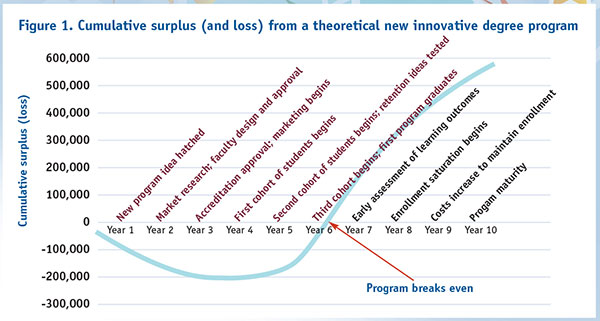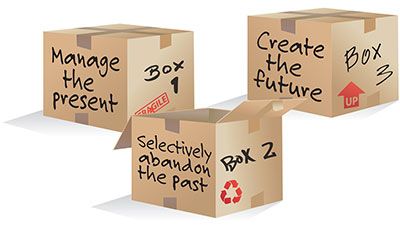
The rapidly changing religious, demographic, technological, and market landscape in North America demands that leaders ask some penetrating questions like these:
-
What kind of education is needed to prepare theologically minded and spiritually formed pastors, missionaries, church planters, counselors, educators, and laity so they can effectively engage with our changing culture?
-
Are we adapting our educational models and delivery systems to make theological education both affordable and accessible to future students?
-
Are we offering other forms of education to meet the needs of the church, including certificates, field training, and materials for people in the pews?
-
Are we implementing our strategic and long-range planning ideas fast enough to be relevant 10 years from now?
In light of these questions, what are you — administrators, faculty leaders, and board members — doing today to create your theological school of the future?
Up-front investment, long-term payoff
Is your school engaging in experimental work today to help create your theological school of 2027? Let’s imagine a typical process that a school might embark upon to revamp its educational model and develop new types of degree programs.
Figure 1 demonstrates a typical innovation time line. Even with diligent management, it is likely that a new educational model may take three years from the original idea before the first student is “sitting in the classroom.” By then, the school will have invested thousands of dollars in market research and advertising, plus hours and hours of faculty and administrative time in design work, accreditation approvals, curriculum approvals, and course development.
It may take three years or more to build up enough students to determine the viability of the program. Then it will take three to four more years to complete a full cycle of teaching through all of the courses in the curriculum.
Figure 1 depicts a successful innovation that eventually breaks even in year six. But if the program idea does not resonate with students and enrollment is lower than expected, the program will never achieve sustainability without an infusion of donor resources or subsidies from other degree programs.
This theoretical example highlights a critically important reality: New educational models have a long incubation period. If we want to be relevant ten years from now, we need to be actively pursuing innovative initiatives today.

Ahead of the curve
I posed this question to Stephen R. Graham, senior director of programs and services at the Association of Theological Schools (ATS): “What are theological schools doing now to learn about alternative educational models that other schools are pursuing?”
Graham is coordinating a project that, among a number of activities, has assembled 110 theological schools into 18 peer groups to study new educational models and practices. “What has struck me is how relatively little schools know about what other schools are doing,” he told me. “Schools will try something that’s innovative for them but maybe it’s already been tried numerous times by other schools. So, one of the things that’s happening in these peer groups is getting people around the table to talk about similar efforts.”
The good news is that the ATS Educational Models and Practices project is spurring many schools to rethink their futures. But if theological schools are going to stay ahead of the innovation curve, they need to focus on faster-paced experimentation to learn, test, and adapt.
The business world has much to say about this. Jeff Bezos, who founded and built Amazon, recently said this at a conference (which was reported by the tech news site GeekWire):
At Amazon, we have to grow the size of our failures as the size of our company grows. We have to make bigger and bigger failures — otherwise none of our failures will be needle movers. It’s a very bad sign over the long run if Amazon wasn’t making larger and larger failures. If you do that all along the way, that is going to protect you from ever having to make that big Hail Mary bet that you sometimes see companies make right before they fail or go out of existence.
I think this spirit of innovation and experimentation is catching on among theological schools. Graham told me this: “Schools are remarkably busy employing new delivery methods, programs for particular constituencies, new models of scheduling, and collaborations with congregations or other schools.” So I asked him to share a few preliminary findings from the New Educational Models work. Here’s what he highlighted:
-
A move to contextual learning. “Many programs are incorporating creative forms of contextual education in congregations and other ministry locations,” Graham said. “It seems that's an emerging or a recovering trend.”
-
Experimentation with competency-based education. One of the peer groups is studying best practices in competency-based education. This group is also relying on contextual learning as a key component for success. “That kind of (competency-based) program only works if you work with the people who are going to be employing the graduates to define exactly what competencies need to be attained,” he reminded me. “It’s inherent in that model that you work closely with your constituents.”
-
New ways of fostering formation for non-residential students. Another peer group is examining formation in the context of online education. “One of the things that those schools are doing routinely is engaging with the congregation or ministry setting of the student, no matter where it is,” he said. “They may do a lot of their work online, but much of the formation will take place in the student's home setting with spiritual directors, ministry mentors, or trained feedback groups within the congregation.”
-
A renewed focus on formation. There seems to be a renewed emphasis on the importance of formation as central to theological students’ preparation for ministry. “Different denominations understand formation differently,” he said, “but I think all of them agree that what happens in theological education not only has an intellectual component but also has to form the person as a person of faith — and someone who can relate to other people.”
Can we balance the present and the future?
Even as more schools think about creating their future educational models, they also have to manage and even improve what they’re doing now. As theological school leaders, we must serve our current students with excellence and prepare them to graduate and be successful in their future ministries. The importance of meeting current educational needs, maintaining short-term financial viability, and striving for continuous improvements in quality cannot be overstated. And most accrediting standards reinforce this priority towards managing the present.
This pressure is even more pronounced for schools that find themselves under significant financial duress. So here’s the natural question: “Can a school responsibly manage its current educational model successfully while still adaptively innovating for the future?”
Most leaders know that innovating requires a different set of competencies, mindsets, and approaches than does optimizing current programs. How can a leader manage such apparently competing challenges?
In the Spring 2014 issue of In Trust magazine, I wrote an article titled “To Create the Future, Selectively Abandon the Past,” which included Figure 2, below. That article was inspired by the formative work of Dr. Vijay Govindarajan, whose thinking has been updated and expanded in his new book, The Three Box Solution. It’s impossible to create an innovative, vibrant future unless a school practices the discipline of selectively abandoning the past, he says. But most schools are so busy with Box 1 (Manage the Present) initiatives, that very little time and energy is devoted to Box 2 (Selectively Abandon the Past) and Box 3 (Create the Future) initiatives.
 |
| Figure 2: The three box solution |
| Adapted from The three box solution: A strategy for leading innovation, by Vijay Govindarajan |
For most theological schools, Box 3 adaptive innovations will take at least 10 years before a complete cycle can be evaluated. So, my question is this: Of all your top institutional initiatives, how many are related to Box 1? Box 2? Box 3?
In my own experience, the practice of identifying, naming, and implementing Box 2 initiatives is rarely done — and it’s most often done as a last resort under the most financially fragile conditions. “Schools rarely stop doing things,” Stephen Graham told me when describing the schools participating in the ATS Educational Models program. “They just add to what they’re already doing. I don't think schools have particularly good processes in place to pull the plug on less essential or viable efforts.”
Why it’s hard to give things up
The reasons for our lack of enthusiasm for Box 2 initiatives are many. In the higher education world, leaders are more reluctant to pursue Box 2 and Box 3 initiatives when their schools fall into one or more of these traps:
-
The Competency Trap. Schools become so good at managing the present that adapting through experimental innovations for an uncertain future seems irresponsible, inappropriate, or at the very least irrelevant. Govindarajan calls this the “Competency Trap,” in which “positive results in the current core business model encourage the organization to invest mainly in Box 1 and provide little incentive for investing in new and future oriented competencies.”
-
The Complacency Trap. The educational models and educational delivery systems within a school are perceived as immutable, resulting in a culture of inertia. Govindarajan says that this trap “shrouds the future in a fog of misplaced confidence, hiding from view a clear understanding of the extent to which the world is changing around you.” Speaking about theological schools in particular, Graham added, “The current form of faculty preparation and roles can be so deeply embedded that it’s almost impossible to make a change unless the school is in really deep crisis.”
-
The Cannibalization Trap. Govindarajan says that leaders who fall into this trap are persuaded that “new business models based on non-linear ideas will jeopardize the organization’s present prosperity or successes.” For theological schools, it can lead to the avoidance of testing new initiatives for fear that possible enrollment gains from experimental (Box 3) initiatives will threaten enrollment in long-established, cherished, and successful current (Box 1) programs.
-
The Operational Trap. When an educational model in decline must be propped up by endless cycles of budget cuts and year-end donor appeals, you know you’ve fallen into this trap. And an institution in the Operational Trap can be sustained for many years through reductions in salaries, retirement contributions, and health benefits; deferrals in building maintenance; and special year-end donor appeals. But far too much institutional energy is devoted towards operational survival (Box 1), while the long-term future of the school remains largely unattended to.
-
The Fear-of-Failure Trap. Box 3 ideas associated with new education models and even bigger breakout ideas are perceived as too risky to warrant the pain of selectively abandoning the past. “Box 3 ideas for the nonlinear future are built from wisps of insights known as weak signals,” Govindarajan writes. And so these yet-to-be-tested ideas are perceived as too risky. To disentangle from this trap, leaders must create a culture that allows for learning faster — and failing faster. The potential gain is the cultivation of bold, transformational ideas.
-
The Safe Haven Trap. Endowment funds, special gifts, and other unusual resources can maintain outdated programs and activities even without adaptation. But with no adaptation to meet new needs, a school that’s living in this trap stays entrenched with curricula, delivery systems, and faculty teaching and research interests that are disconnected from the current needs of the church.
-
The Peacekeeper Trap. Organizational structures or policies can provide a sense of fairness and stability within an organization, and any significant changes can put this precarious balance at risk. “We surveyed academic deans and program directors and asked them about the most significant impediment to fulfilling the goals of their programs,” Graham said. “Across the board, the answer was ‘insufficient human resources.’” The Peacekeeper Trap discourages leaders from engaging in periodic realignment of human resources, structures, and policies to match their emerging educational models.
These traps keep leaders from venturing into Box 3 territory and instead anchor theological schools and their leaders in the world of Box 1 initiatives. To bring balance to the boxes, it’s useful for leaders to answer a few questions:
1. What are your deeply rooted mindsets and practices that inhibit adaptive innovations?
Ideas:
2. If you don’t make changes to meet the new needs of your stakeholders, including the churches that support you, what will threaten your long-term viability?
Ideas:
-
Clarify the vision for your theological school’s future. Based on that work, develop and prioritize your top Box 3 initiatives.
-
Enter Box 3 territory with a spirit of experimentation — expecting failures, but also expecting to learn from them.
3. What policies, structures, and programs are a drain on your energy, focus, financial resources, and creativity?
Ideas:
-
Develop a trusted, open process that can lead to specific Box 2 initiatives — programs that can be discarded.
-
Prioritize Box 2 initiatives based on Box 3 initiatives, setting a timeline to abandon policies, structures, and programs based on those that prevent you from Box 3 work.
4. How will you increase the pace and volume of Box 3 innovations in ways that are different from the rules that govern the processes required in the Box 1 educational model?
Ideas:
-
Develop a new culture that is open to “pilot testing” before final educational models are selected.
-
Find ways to sufficiently fund and organize Box 3 initiatives. Experiment with streamlined processes to test new ideas on the market more quickly.
-
Organize for quicker learning, not short-term earning.
Every theological school faces an uncertain future. But, with God’s help we can gain a better perspective of where he is leading us and how we can labor together in creating the theological school of the future. The time to start is now.